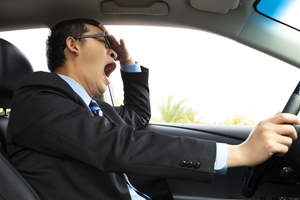 Not driving while fatigued may seem like a no-brainer, but the New South Wales government is still concerned about the number of people who are threatening safety on the state’s roads by driving whilst fatigued and drowsy. According to Transport for New South Wales, fatigue is one of the main causes of road fatality, with research suggesting it is just as dangerous as drink driving.
Not driving while fatigued may seem like a no-brainer, but the New South Wales government is still concerned about the number of people who are threatening safety on the state’s roads by driving whilst fatigued and drowsy. According to Transport for New South Wales, fatigue is one of the main causes of road fatality, with research suggesting it is just as dangerous as drink driving.
Your body on sleep – the science behind tiredness
Our bodies are governed by circadian rhythms which determine when we should be asleep and when we should be awake, meaning that at night and sometimes during the afternoon we find our performance inhibited. This effect is amplified when we do not get enough sleep, or when we sleep poorly, as this disturbs our natural sleeping patterns. So even if you work at night, it is worthwhile being aware that your body is still hardwired to sleep after the sun’s gone down.
One of the main dangers of fatigued driving is a brief lapse in consciousness known as a microsleep. Many people may be familiar with the drooping eyelid sensation and then the jarring moment of resurfacing, as though you’ve missed the last few seconds of whatever is going on. This sensation is more likely to happen in a monotonous situation, such as driving.
Research from the University of Wisconsin-Madison has found that signs of sleep-like activity are present in the brain even before microsleep can occur. When monitored, it also appears that our regular, waking brain waves are effectively replaced by brain waves which occur during REM sleep. On average, microsleep can last anything from a fraction of a second to even ten seconds or more. This is just long enough for us to miss the braking of another vehicle, a sharp turn or any other obstacle crossing our path.
What to do if you’re feeling tired behind the wheel
While fatigued younger drivers tend to be involved in night-time crashes, for those who are older, fatigue-related incidents appear to occur more in the ‘siesta’ hours of the afternoon.
According to Transport for NSW, driving performance for someone who hasn’t slept in 17 hours is the same for someone with a blood alcohol reading of 0.05. Sleeping drivers can also become the centre of tragic and fatal accidents, as unlike other drivers under the influence of alcohol or other illegal substances, they are unable to brake in response to changes in the road.
In order to prevent this, getting a good night’s sleep and avoiding driving at late hours when your body is naturally inclined to sleep are two of the strongest options. NSW’s Centre for Road Safety also advises against long drives after a day at work, as well as planning rest periods for long drives and sharing time behind the wheel.
If you begin to feel tired while on the road, pull over as soon as you find a safe place to do so, and take a rest. A 20 minute power nap is an effective way of recharging – also if possible, swap drivers.
Remember that the only real cure for tiredness, is of course, proper sleep.
Reaching out to a wider audience
Stop Revive Survive is just one of the anti-fatigue campaigns which aims to change the behaviour of NSW drivers. Stop Revive Survive helps drivers to recognise the early signs of fatigue such as poor concentration, slow reactions and tired eyes before you drift off at the wheel. There are also rest area maps available to download from the Roads and Maritime website for you to plan your breaks.
Test Your Tired Self is an online interactive quiz consisting of simple memory and reaction time tasks to help drivers to determine whether they’re awake enough to drive.
The NSW government reminds drivers that they are six times more likely to die in a crash when tired than any other drivers. In 2012 alone, fatigue crashes took more lives than those related to drink driving.
If you are a driver in NSW, make sure your comprehensive insurance, CTP green slip and registration are up to date, and that you remain vigilant of yourself and others on the road at all times.
your opinion matters: